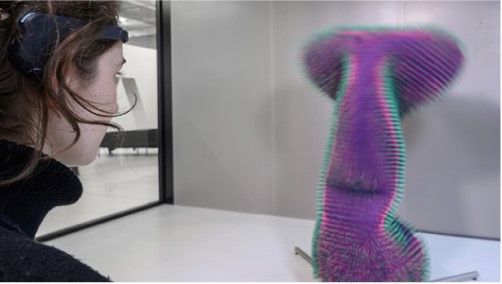“DOING NOTHING WITH AI”, EMANUEL GOLLOB (AT)

Title of the artwork: Doing Nothing with AI 1.0
Author: Emanuel Gollob
Date: 2019
Source:
https://www.emanuelgollob.com/doing-nothing-with-ai/
ARTWORK ABSTRACT IN WORDS OF THE ARTIST
The project develops visually as a reaction to a society that keeps changing. But my approach to the project has also been changing. The colors of the installations are based on Instagram stories and scrolling through websites. I was thinking about the way we use our smartphones too much and how it changes our perception. Now, I don’t think this behavior is necessarily a bad thing anymore. I think we should observe it and work with it.
The idea behind the project is the feeling that doing nothing today is seen as something negative and almost provocative. Doing nothing seems to express laziness, while doing something is often associated with productivity and efficiency. “In an environment of ever-increasing pace and pressure and where connection through technical devices is vital, I confront people with machines whose aim is to inactivate them.”
GET INSPIRED
From a neuroscientific point of view, differences in brain processes can be seen when the person is working on an active task or not. With generative machine learning, Gollob’s machines convert the results of these measurements into “feedback” through which they choose their next moves. The functional goal is to generate a state with brain activity that shows no active task and the audience is therefore doing nothing.
WHAT DOES THIS WORK TRANSMIT TO US?
What materials / media are used in the work and why?
It is a robotic art installation (Kuka Robot KR6R900) covered by a foam skin full of spines that uses generative robotic control, EEG perception and a GAN (Generative Adversarial Networks) machine learning model to optimize its choreography for metrics with the goal of making the viewer do nothing.
This artificial creature moves and changes color. The second version also changes its sound. But these effects don’t happen randomly. They are a reaction of the artificial intelligence to the EEG waves generated by the viewer, measured with a headset. Thus, the artwork can observe brain activities.
From a neuroscientific point of view, differences in brain processes can be seen when the person is working on an active task or not. With generative machine learning, Gollob’s machines convert the results of these measurements into feedback through which they choose their next moves. The functional goal is to generate a state with brain activity that shows no active task and the audience is therefore doing nothing.
What is the significance of the elements of the work?
In times of constant hustle and bustle, technological overload and demand for constant responsiveness to information, there is little acceptance of “doing nothing”, often seen as provocative and associated with a waste of time. People seem to be always in a hurry, filling their schedules, seeking distraction and the subjective feeling of control, unable to tolerate even short periods of inactivity. This multidisciplinary project attempts to address the common misconception, in the author’s opinion, of confusing busyness with productivity or even efficiency. Taking a closer look, there is not much substance in checking our emails or checking our cell phone every time there is a five-minute wait at the subway station. Enjoying a moment of inaction and introspection while letting our minds wander and daydreaming can be more productive than constantly keeping ourselves busy doing something.
About the artist
With his artistic practice Emanuel Gollob (Austria, 1991) unites the knowledge bases of aesthetic research, robotics and the interaction between system and AI. The viewer’s emotions when perceiving his works are most important to him. Therefore, in his projects, he explores different methods to interact with them. Gollob graduated from the University of Applied Arts Vienna with a diploma in Design Research (2019). He is currently artist in residence at MindSpaces, an EU research project in the framework of the STARTS initiative. Since 2020 he is a doctoral candidate and artistic researcher at the University of Art and Design Linz.
Author of the analysis: Carmen Salazar Pera

